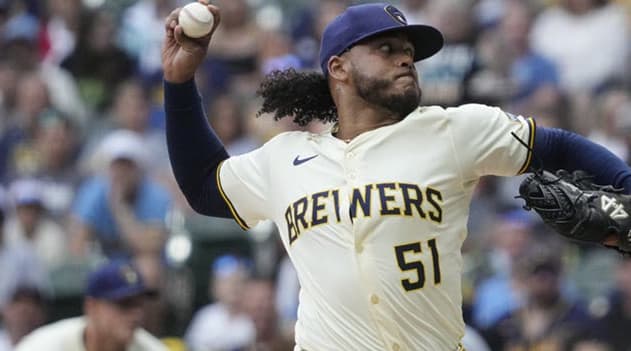I chose Steamer's historic projections as a test group. One data anomaly I found immediately was that the projected number of plate appearances ran a little high; I talked to the creator of Steamer, Jared Cross, who said he wasn't aware of the issue but will look into it.
Even with the small bias, Steamer is considered the most accurate projection system and is always upgrading, such as using pitch velocity as an input. It's a perfect projection system for today's study.
The Steamer projections go back to 2010, and the plate-appearance numbers are derived from FanGraphs fan playing time estimates and depth charts.
To start, here are the plate-appearance distributions compared to the actual results by percentiles.
| PA | PERCENTILES | 90% | 75% | 50% | 25% | 10% | COUNT |
| >700 | Projected | 738 | 722 | 708 | 705 | 702 | 23 |
| Actual | 716 | 709 | 674 | 511 | 351 | ||
| 651 to 700 | Projected | 689 | 680 | 666 | 656 | 652 | 183 |
| Actual | 700 | 681 | 648 | 573 | 425 | ||
| 601 to 650 | Projected | 647 | 637 | 625 | 614 | 606 | 340 |
I chose Steamer's historic projections as a test group. One data anomaly I found immediately was that the projected number of plate appearances ran a little high; I talked to the creator of Steamer, Jared Cross, who said he wasn't aware of the issue but will look into it.
Even with the small bias, Steamer is considered the most accurate projection system and is always upgrading, such as using pitch velocity as an input. It's a perfect projection system for today's study.
The Steamer projections go back to 2010, and the plate-appearance numbers are derived from FanGraphs fan playing time estimates and depth charts.
To start, here are the plate-appearance distributions compared to the actual results by percentiles.
| PA | PERCENTILES | 90% | 75% | 50% | 25% | 10% | COUNT |
| >700 | Projected | 738 | 722 | 708 | 705 | 702 | 23 |
| Actual | 716 | 709 | 674 | 511 | 351 | ||
| 651 to 700 | Projected | 689 | 680 | 666 | 656 | 652 | 183 |
| Actual | 700 | 681 | 648 | 573 | 425 | ||
| 601 to 650 | Projected | 647 | 637 | 625 | 614 | 606 | 340 |
| Actual | 691 | 665 | 595 | 503 | 361 | ||
| 551 to 600 | Projected | 596 | 586 | 575 | 561 | 556 | 394 |
| Actual | 668 | 626 | 547 | 415 | 275 | ||
| 501 to 550 | Projected | 546 | 541 | 529 | 514 | 506 | 297 |
| Actual | 641 | 590 | 493 | 340 | 194 | ||
| 451 to 500 | Projected | 495 | 485 | 474 | 461 | 453 | 235 |
| Actual | 603 | 531 | 439 | 321 | 239 | ||
| 401 to 450 | Projected | 446 | 438 | 427 | 416 | 407 | 186 |
| Actual | 578 | 492 | 399 | 259 | 136 | ||
| 351 to 400 | Projected | 398 | 388 | 374 | 360 | 355 | 163 |
| Actual | 503 | 429 | 328 | 219 | 103 | ||
| 301 to 350 | Projected | 343 | 335 | 322 | 310 | 305 | 155 |
| Actual | 537 | 418 | 273 | 166 | 68 | ||
| 251 to 300 | Projected | 293 | 283 | 273 | 262 | 255 | 230 |
| Actual | 511 | 367 | 255 | 161 | 105 | ||
Thoughts on this data:
• With a 30-PA bias factored in, the 10th and 25th percentiles see a significant drop in plate appearances. Owners should expect at least a 33 percent drop in projected plate appearances for at least 25 percent of their full-time players. And for 10 percent of the hitters, the drop is 41 percent. Basically, on a normal 14-man lineup, three to four hitters will not live up to expectations, with one to two seeing a huge drop.
• While the players projected for at least 600 PA don't have a ton of upside, the players from 450 to 600 do. This group contains injury-prone players like Giancarlo Stanton and Alex Gordon, who could stay healthy for the season and collect 650 PA … or could get injured again.
• Anyone with less than 400 projected plate appearances usually doesn't break out for full-season playing time. The low 500s is the best-case estimate.
On to the next table, which contains the projected OPS for each plate-appearance bucket:
| PA BUCKET | PROJECTED MEDIAN OPS | ACTUAL MEDIAN OPS | DIFFERENCE |
| >700 | .850 | .839 | -.011 |
| 651 to 700 | .810 | .789 | -.021 |
| 601 to 650 | .780 | .767 | -.013 |
| 551 to 600 | .759 | .737 | -.023 |
| 501 to 550 | .742 | .721 | -.021 |
| 451 to 500 | .738 | .726 | -.012 |
| 401 to 450 | .722 | .693 | -.029 |
| 351 to 400 | .703 | .689 | -.014 |
| 301 to 350 | .700 | .684 | -.016 |
| 251 to 300 | .697 | .659 | -.038 |
No surprises with this table. The best players get the most plate appearances. A small drop in performance exists, but the projections are solid.
For this next table, I divided out players from each plate appearance bucket by OPS. I set the dividing mark at .780 OPS, which is the average value for hitters with 600-plus plate appearances. Only three players were below the mark in the 700-plus bucket, so I ignored that group.
| PA BUCKET | PA PERCENTILE | 90% | 75% | 50% | 25% | 10% |
| 651 to 700 | High OPS | 705 | 682 | 649 | 574 | 443 |
| Low OPS | 698 | 675 | 640 | 573 | 391 | |
| Diff | 7 | 7 | 9 | 1 | 52 | |
| 601 to 650 | High OPS | 695 | 667 | 613 | 505 | 365 |
| Low OPS | 688 | 658 | 583 | 499 | 354 | |
| Diff | 7 | 9 | 30 | 6 | 11 | |
| 551 to 600 | High OPS | 666 | 626 | 558 | 436 | 317 |
| Low OPS | 672 | 630 | 543 | 399 | 244 | |
| Diff | -6 | -4 | 15 | 37 | 73 | |
| 501 to 550 | High OPS | 648 | 610 | 512 | 357 | 235 |
| Low OPS | 626 | 584 | 493 | 336 | 190 | |
| Diff | 22 | 26 | 19 | 21 | 45 | |
| 451 to 500 | High OPS | 650 | 534 | 448 | 344 | 278 |
| Low OPS | 594 | 526 | 438 | 313 | 239 | |
| Diff | 56 | 8 | 10 | 31 | 39 | |
| 401 to 450 | High OPS | 585 | 522 | 441 | 238 | 146 |
| Low OPS | 563 | 491 | 398 | 260 | 136 | |
| Diff | 22 | 31 | 43 | -22 | 10 | |
| 351 to 400 | High OPS | 441 | 402 | 324 | 242 | 63 |
| Low OPS | 503 | 431 | 332 | 219 | 103 | |
| Diff | -62 | -29 | -8 | 23 | -40 | |
| 301 to 350 | High OPS | 649 | 478 | 244 | 192 | 185 |
| Low OPS | 521 | 415 | 274 | 165 | 65 | |
| Diff | 128 | 63 | -30 | 27 | 120 | |
| 251 to 300 | High OPS | 442 | 285 | 210 | 161 | 118 |
| Low OPS | 514 | 373 | 258 | 162 | 105 | |
| Diff | -72 | -88 | -48 | -1 | 13 |
Thoughts on this table:
• Anyone projected for more than 600 PA will play no matter his projected OPS. These weak hitters are probably defensive wizards who continue to play because of their gloves, not their bats.
• From about 400 to 550 projected plate appearances, the cream rises to the top, with the better hitters getting about 20 to 30 additional plate appearances.
Because of the uncertain playing time, it's each owner's responsibility to have a good handle on projected plate appearances. A player who opens the season on the DL will see his plate appearances drop, naturally. The difference may seem small, but they can add up when multiple players are adjusted.
Here are some situations to monitor with the hitters' potential playing time in flux:
Any Cub without the last name Rizzo or Bryant: The Cubs' roster contains too many MLB-caliber players and not enough lineup spots to go around. (This situation was even more of a mess before Jorge Soler was traded to the Royals.) Ben Zobrist, Addison Russell and Javier Baez will be splitting time between the two middle-infield spots; Zobrist joins Jason Heyward, Jon Jay, Albert Almora and Kyle Schwarber in the outfield mix. If everyone stays healthy, that could mean 450 plate appearances each.
Jung Ho Kang: Kang didn't receive any jail time for his DUI in Korea. He still may miss time, as the team or league may suspend him, but no news on the situation has come out yet.
Albert Pujols and Michael Brantley: Neither has played in spring games yet. Pujols is getting close to his first action, but Brantley is not close at all.
Plate appearances remain a dull topic. They're not home runs, RBI or stolen bases. But in truth, they are. The more plate appearances a player makes, the more chances he has to accumulate precious fantasy stats. By diligently tracking changes in plate appearances, we can identify players to target and avoid on draft day.






























